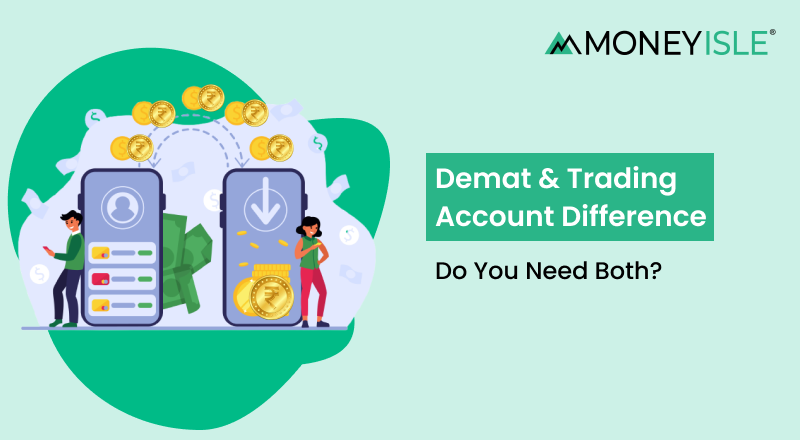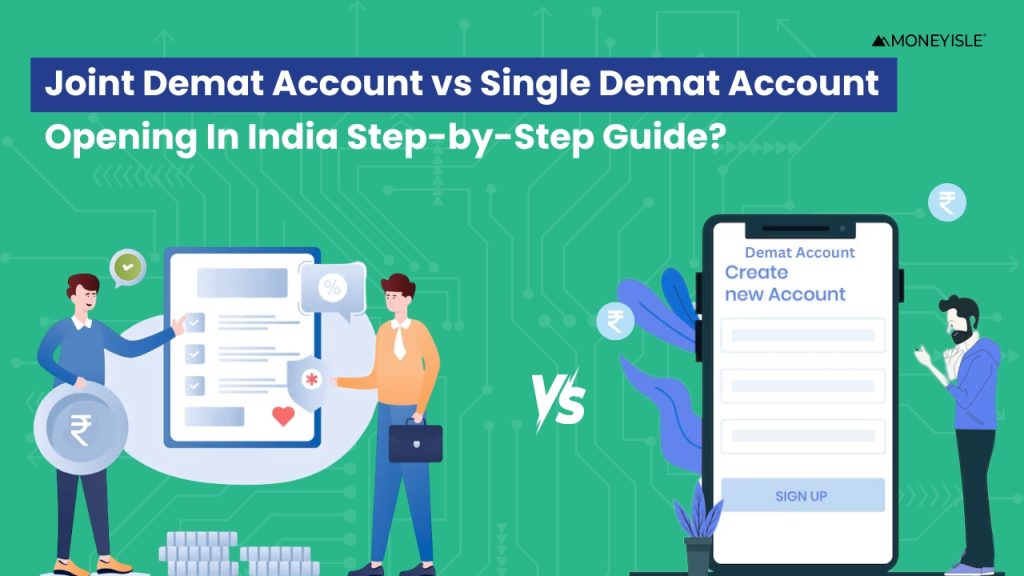Unlocking the doors to the stock market with a Demat Account and a Trading Account – two keys to a single investment journey.
Think of a Demat Account like a digital vault where you store your shares, and a Trading Account as the platform where you buy and sell them. You need both to invest in the stock market!
“An investment in knowledge pays the best interest.” — Benjamin Franklin
“The stock market is a device for transferring money from the impatient to the patient.” — Warren Buffett
Patience is essential in investing! But, having the right tools is equally important. Understanding the Demat and trading account difference is crucial.
Understanding the distinction can be useful in navigating the stock market with confidence. Keep reading!
What is a Demat Account and Trading Account?
A Demat account is short for “dematerialised account.” It stores your securities digitally. This replaces paper certificates. Therefore, it results in reducing risks like loss or forgery. Your shares, bonds, ETFs, and mutual funds are all held in one place in an absolutely secure way.
A trading account is your operational gateway to the stock market. It lets you place buy or sell orders on exchanges like NSE and BSE. Essentially, the trading account executes, and the Demat account stores. Both are required for a seamless investing experience.
Unlock your investment potential with a Demat and Trading Account – your keys to the stock market! Open both accounts today and start trading your way to financial freedom.
Manage investments, monitor listings, and make informed decisions at MoneyIsle.
Recommended Read: Demat Account Explained: Everything You Should Know Before Investing To Reap Profits
Do You Need Both a Demat and Trading Account?
Yes, for almost all investors. The trading account lets you buy and sell securities, while the Demat account stores your holdings securely. Operating with only one account either prevents trading or restricts holding shares safely. Both accounts are essential for smooth, compliant investing.
Can I Open Only One of the Two Accounts?
- Only Demat account: Useful for inherited shares or IPO allocations, but selling requires a trading account.
- Only trading account: Sufficient only for derivative trading (Futures & Options), which are cash-settled.
For equity delivery and long-term investments, opening both accounts together is the most practical approach.
What is a Demat Account? (Demat Account Explained)
The Demat account explained is straightforward: it’s a secure, digital locker for all financial instruments. It can hold:
- Equity shares
- Bonds and government securities
- Exchange-Traded Funds (ETFs)
- Mutual funds
Your Demat account is held with a Depository Participant (DP) registered on either CDSL or NSDL, making it safe and transparent. It serves as an electronic safe deposit, giving you secure possession of your investments and removing the traditional risks of paper certificates.
Recommended Read: Benefits of a Demat Account Opening for LLPs and Partnership Firms in India
What is a Trading Account? (Trading Account Explained)
A trading account connects your bank and Demat accounts, allowing you to:
- Execute market or limit orders
- Access margin funding and derivatives trading
- Trade with confidence on NSE and BSE
While your Demat account holds your investments, the trading account lets you act on market opportunities. Both work together to create a complete investing ecosystem.
Demat Account vs. Trading Account: Side-by-Side Comparison
Feature | Trading Account | Demat Account |
Purpose | To place buy and sell orders for securities. | To hold and store securities in electronic format. |
Where it’s held | With a SEBI-registered stockbroker. | With a Depository Participant (DP) of CDSL or NSDL. |
Role in a transaction | Executes the transaction on the stock exchange. | Receives or debits shares after settlement. |
Required for? | Buying and selling shares (equity delivery & intraday). | Holding shares after purchase. |
Example workflow | You place a “buy” order for 10 shares of a company. | The 10 shares are credited to your account after settlement. |
Common Charges | Brokerage fees, transaction charges, stamp duty. | Account Opening Charges, AMC, and DP charges. |
How the Typical Buy/Sell Cycle Works (Step-by-Step)
Understanding the transaction flow clarifies why both accounts are needed:
- Placing the Order: Log in to MoneyIsle GraphUp and select shares to buy.
- Execution: Broker routes your order to NSE or BSE, matching it with a seller.
- Settlement: Trades settle on a T+1 cycle, with shares delivered the next business day.
- Transfer to Demat: Purchased shares are credited to your Demat account for safe keeping.
Empower your financial decisions with MoneyIsle’s personalised tools and guidance — from trading to portfolio tracking, you’re never alone.
Charges & Documents: What You Need to Open Each
Documents Required:
- PAN Card
- Aadhaar Card (for e-KYC)
- Proof of address
- Proof of bank account (cancelled cheque or statement)
- Passport-sized photograph
Common Charges:
- Account Opening Fee: Many brokers, including MoneyIsle, offer zero-fee options.
- Annual Maintenance Charge (AMC): Fee for maintaining your Demat account.
- Brokerage: Fee charged on each trade through your trading account.
- Other Charges: Stamp duty, DP charges, and other regulatory fees per transaction.
How to Open a Demat & Trading Account in India
Opening both accounts is simple:
- Select Broker: Select MoneyIsle, a small boutique firm that has an experienced team of consultants and approachable owner in Chandni Chowk, serving Kashmere Gate, Daryaganj and Chandni Chowk.
- Full e-KYC: Aadhaar-based mobile verification is through the MoneyIsle eKYC Portal.
- Sign Digitally: Sign and e-sign forms online.
- Link Bank Account: This is a way to make sure that money changes hands.
- Start Investing: Use GraphUp, PriMarket, or Deck to manage holdings efficiently.
MoneyIsle’s Suite of Tools for Every Investor
- GraphUp: Trading platform with live market data.
- PriMarket: Web-based IPO application integrated with trading.
- Deck: Live portfolio dashboard with Single Sign-On (SSO).
- eKYC Portal: Fully digital onboarding for Indian residents.
MoneyIsle also provides offline advice to businesses, integrating personalised advice with technology-powered platforms to create a full-boutique approach to investing.
Recommended Read: Joint Demat Account vs Single Demat Account Opening In India – Step-by-Step Guide?
Your Next Step in Investing
Having the knowledge of the Demat and trading account difference makes investing smarter and safer. MoneyIsle offers you the knowledge and care of a seasoned expert, a personalised experience, and easy-to-use tools, all in a boutique-like experience of investing.
Start today — open your Demat and trading account with MoneyIsle and trade with clarity, control, and confidence.
Frequently Asked Questions (FAQ)
A Demat is an account where securities are kept electronically, whereas a trading account is an account which allows buying and selling in NSE/BSE. Both are essential.
Yes. The trading accounts are used to carry out the transactions, and the Demat accounts are used to store the shares purchased.
Yes, but this constrains your actions. A Demat-only account does not allow the sale, and a trading-only account does not allow holding shares.
Only for derivatives (F&O). Delivery of equity trade is made in a Demat account.











